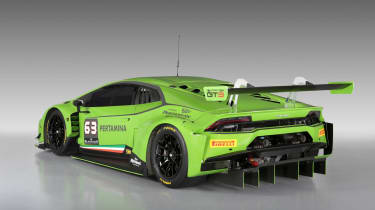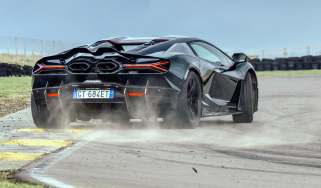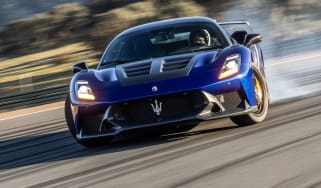Lamborghini Huracán GT3 debuts to take on McLaren 650S GT3
Sant'Agata's latest collection of scoops and curves will make its race debut at Monza in April
Lower, lighter, stiffer, less powerful, but generally much, much more hardcore than the standard road car, this is the new Lamborghini Huracán GT3.
Due to debut at Monza in April during the first race in the Blancpain Endurance Series, the bewinged racer is the second Huracán-based track car, after the 612bhp Super Trofeo that will compete in Lamborghini’s one-make series.
Despite the fantastically tawdry livery and bulging bodywork, the most significant change from the road car is that the 5.2-litre V10 sends power solely to the rear wheels via a sequential six-speed gearbox and a three-disc racing clutch.
The GT3’s stopping power should be a cut above that of the road car, too, as although the steel discs are the same size as the ceramics on a dealership-spec Huracán, they only have to rein in a featherweight 1239kg, not 1532kg.
The car’s aerodynamic properties have been developed with Dallara and are influenced by louvres over the front wings, scimitar-style canards, a cavernous rear diffuser and an adjustable ‘gooseneck’ rear wing. Sprawling sills also help keep air pressure underneath the GT3 low at high speeds, helping to suck the floor onto the racetrack.
The rear end of the car is also dramatically open-worked in a bid to keep engine temperatures reasonable, while the road-going Huracán’s exhaust has been truncated, with the outlets migrating upwards and inwards. Heat from the brakes is allowed to escape through extensive vents in the front wheelarch.
Underneath its skin, the Huracán GT3 boasts an aluminium and carbon chassis, which is largely carried over from the road car, and achieves the same 42/58 front/rear weight distribution.
Cornering grip will be extraordinary, as the race car wears 325-section tyres at the rear and 315-section at the front, governed, for better or for worse, by 12-stage ABS and Bosch Motorsport traction control.
Final performance figures are yet to be confirmed as the car is still undergoing final homologation certification, but around 490bhp and a top speed of 170mph due to short gearing are expected.
Sant’Agata’s latest race car is further evidence that Lamborghini’s engineers have the expertise to build a rear-wheel-drive Huracán for the road in the mould of the popular Gallardo LP550-2 Balboni. Limited to 250 examples, the special edition was named after the firm’s chief test driver Valentino Balboni and remains the purist’s modern-era Lamborghini.
Lamborghini is asking for 369,000 euros for the Huracán GT3, which is on par with McLaren’s £330,000 price tag for the 650S GT3.








